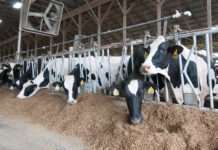Let’s hit the hardwood. No, I’m not referring to chopping firewood for winter.
In this case, hardwood refers to the hardwood floor of old-time basketball gyms across Kansas. Today we’ll meet a Kansas author who has written a book about classic basketball gyms in towns small and large across the state.
Brian Stucky is a retired teacher, author and artist in Goessel. He grew up on a farm near Goessel and attended Liberty Rural Grade School. He credits his parents, Ransom and Mary Stucky, for spurring his interest in basketball.
“Dad taught us fundamentals and mom was our number one fan,” he said. The senior Ransom even made the all-conference team while playing for Bethel College in 1948.
Brian carried on his father’s interest in basketball. At Moundridge High School, Brian played on the school’s first state champion team in 1971. He went on to play at Bethel College himself, including the tournament team of the 1973 KCAC champions.
Brian pursued a long and successful career in teaching and coaching basketball, volleyball and track at high schools and junior highs in Buhler and Goessel before retiring. As a track coach, he coached 13 individual state champions and two AAU national champions. In 1984, he carried the Olympic torch in the torch relay.
Brian had great memories of the classic old basketball gyms of yesteryear. As schools modernized their facilities, Brian observed that some of these antique gyms were lost. He began a six-year journey around Kansas to find gyms that had been built before 1950 and that were in nearly original condition, and to photograph them with a related legendary old coach, player or personality.
In 2003, he published those stories and photos in a book titled “Hallowed Hardwood – Vintage Basketball Gyms of Kansas.” It is a collection of vignettes, each two pages with multiple photos of the gyms and the stories of the players, coaches and notable fans who participated in them. The book has been reprinted and revised twice since then.
“I had no idea I would catch lightning in a bottle like this,” Brian wrote. He received an award from the Kansas Basketball Coaches Association for preserving the history of the game of basketball.
The book includes stories of 25 small town gyms, 15 larger school gyms, five community buildings and six college gyms. Among those were stories of Roy Williams at Allen Fieldhouse and Ernie Barrett – known as Mr. K-State — at Ahearn Fieldhouse.
The small town stories span the alphabet, from Appanoose to Zenith. They are the tales of championship teams, white-hot rivalries, dusty trophy cases and games played in cracker box gyms so small that the free throw circle overlaps half court. There are the antique gyms where a balcony hangs over the court and the wall is out of bounds.
There are also stories of the Tescott team that went undefeated in 1957, and Jackie Stiles setting the state scoring record at Claflin with her tenacious work ethic.
There’s the incredible tale of the coach at Clements in 1951 who disciplined his star player by making him sit out a game. The player’s father, who had recently gotten out of jail for murder, threatened to kill the coach if his son didn’t play. The coach stuck to his guns, so to speak, and benched the player when they played at rival Cedar Point.
Clements fans were so mad that they mobbed the coach as he left the gym. Just then, some other fans from Clements showed up with pitchforks and baseball bats to support the coach and escort him to safety. Brian Stucky wrote: “He was saved by peasants with pitchforks.”
These classic gyms are found in places as small as Plevna, population 98; Wallace, population 57; and Cedar Point, population 28 people. Now, that’s rural.
For more information or to order the book, go to www.hallowedhardwood.com.
Let’s hit the hardwood – not firewood for the winter, but the old hardwood floors where basketball was played a half-century ago. We commend Brian Stucky for making a difference by preserving and chronicling such history. As a play-by-play announcer would say after a made basket: “It’s good!”
Audio and text files of Kansas Profiles are available at http://www.kansasprofile.com. For more information about the Huck Boyd Institute, interested persons can visit http://www.huckboydinstitute.org.
-30-
The mission of the Huck Boyd National Institute for Rural Development is to enhance rural development by helping rural people help themselves. The Kansas Profile radio series and columns are produced with assistance from the K-State Research and Extension Department of Communications News Media Services unit. A photo of Ron Wilson is available at http://www.ksre.ksu.edu/news/sty/RonWilson.htm. Audio and text files of Kansas Profiles are available at http://www.kansasprofile.com. For more information about the Huck Boyd Institute, interested persons can visit http://www.huckboydinstitute.org.
K State Research and Extension is a short name for the Kansas State University Agricultural Experiment Station and Cooperative Extension Service, a program designed to generate and distribute useful knowledge for the well being of Kansans. Supported by county, state, federal and private funds, the program has county extension offices, experiment fields, area extension offices and regional research centers statewide. Its headquarters is on the K State campus in Manhattan. For more information, visit www.ksre.ksu.edu
Column by:
Ron Wilson
[email protected]
785-532-7690




